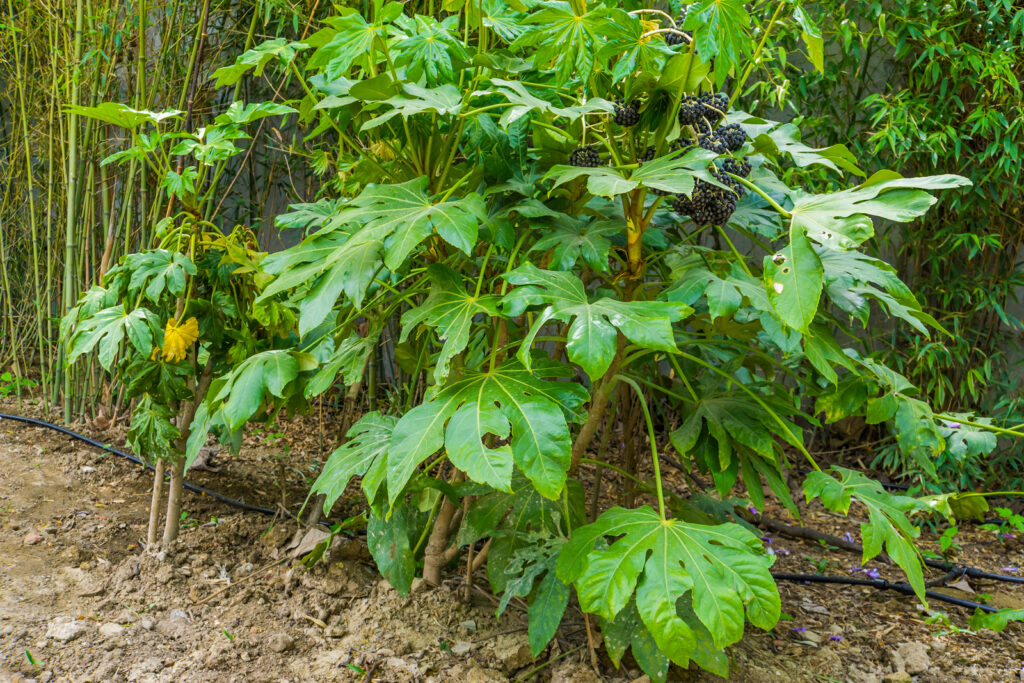Fatsia–commonly called Japanese aralia– is a fast-growing evergreen shrub or houseplant. It grows well in cool situations and low light. It is a good choice for the shade garden or low light entries.
Fatsia is a genus of only 1 species and 2 cultivars. It is a quick-growing and long-lasting plant. Fatsia has a single, woody stem that supports long leafstalks and huge leaves. Fatsia grows to 5 feet tall (1.5m) with leaves that can grow to 18 inches (45cm) across.
Fatsia is an ideal shrub for a shaded, sheltered location such as a courtyard or walled garden. It is a long-lived houseplant that doesn’t mind a cool situation.
Get to know Fatsia
- Plant type: Evergreen shrub
- Growing Zones and range: Zones 8-10
- Hardiness: Prefers days about 65°F (18°C) and nights around 50°F (10°C); protect plants from extreme wind
- Height and width: 3 to 5 feet (1-1.5m) tall, 6 to 8 feet (1.8-2.4m) wide
- Foliage: Large, palmately lobed, glossy, leathery leaves; leaves can grow to 12 inches (30cm) across
- Flowers: Small creamy white flowers
- Bloom time: Mid-autumn
- Uses: Shade-loving; bold tropical texture; entries, patios, courtyards
- Common name: Japanese Aralia
- Botanical name: Fatsia japonica
- Family: Araliaceae
- Origin: Eastern Asia
Where to plant Fatsia
- Fatsia will grow in partial to dense shade; protect the plant from afternoon or winter sun.
- Indoors grow Fatsia in bright to moderate light with direct sun in winter from an eastern , western, or southern exposure.
- Grow Fatsia in moist, acidic soil rich in organic matter; will tolerate soils from sandy to heavy clay, but not soggy soil.
- Indoors plant Fatsia in an all-purpose potting mix.
How to water and feed Fatsia
- Water Fatsia regularly. Keep the soil moist in spring and summer; reduce watering in fall and winter, but do not let the soil dry out.
- Fertilize Fatsia twice a year in early spring and early summer.
- Keep Fatsia bushy by trimming stem tips in spring.

Fatsia care
- Provide Fatsia extra humidity in warm temperatures.
- Repot Fatsia as needed in spring.
- If Fatsia stems get leggy, cut them back by half in spring.
- Care should be taken when handling fatsia; its new leaves are tender and bruise easily.
Growing Fatsia as a houseplant
- Fatsia needs bright to direct light. It can be grown under fluorescent light.
- Fatsia does best in cool to average room temperature with low to medium humidity.
- Keep the soil moderately dry.
- Fertilize Fatsia regularly during spring and summer; use a liquid fertilizer at half strength.
Fatsia pests and diseases
- Fatsia is susceptible to attack by aphids, mealybugs, scale insects, and spider mites.
Fatsia propagation
- Take Fatsia cuttings in late winter and spring or grow new plants from seed.
Fatsia varieties to grow
- Fatsia japonica, fomerly listed as Aralia japonica. Grows to 5 feet (1.5m) tall with woody stems and leafstalks; many lobed leaves are light green and shiny. Cultivars ‘Moseri’ is compact with yellow veining in the leaves; ‘Variegata’ has creamy white margins on leaves.



